Basketball Offense - Triple-Post "T-Game" Offense
From the Coach’s Clipboard Basketball Playbook"Helping coaches coach better..."
Disclosure: This page contains affiliate links, which means that Coach's Clipboard receives a small commission (at no cost to you) if you make a purchase using these links.
First, this "triple post offense" is not the same and is not to be confused with the "triple post offense" or "triangle offense", originated by Sam Barry and refined by Tex Winter and Phil Jackson. This "T-Game" offense we are discussing here was developed by legendary Hall of Fame coach Dean Smith. Coach Smith was head men's coach at the University of North Carolina from 1961 through 1997. He compiled 879 career wins and won two NCAA National Championships, as well as having eleven Final Four appearances, and was voted four times the National Coach of the Year.
Coach Smith used multiple offenses and defenses, and the T-game was only one of his many weapons.

Coach Dean Smith
The T-game can be used vs either man-to-man or zone defenses. It is flexible using either a "single-post" or a "triple-post" option. The offense is based on spacing and movement, with little screening, and has continuity from side to side. Like other "patterned" offenses, it is somewhat predictable, but as with all offenses, execution is the key.
The T-game is fairly easy to learn. O3, O4 and O5 are interchangeable and all learn the same roles, whereas O1 and O2 are also interchangeable.
The T-Game Pattern
O1 brings the ball across half-court (diagram A). O3 and O4 start on the blocks. O5 starts on either lane side, or at the high-post. O2 starts in the middle between the free-throw line and the arc. O1 dribbles to either wing. This triggers the ball-side low post to cut to the corner for the pass from O1.O2 pops out to the opposite wing. As the ball is dribbled to the wing, O5 cuts to the ball-side elbow. Once the pass is made from O1 to O4 (in the corner), O5 cuts to the ball-side low block and posts-up, looking for the pass from O4. Meanwhile, O3 cuts to the ball-side elbow, vacated by O5. After O1 passes (diagram B), he/she cuts inside and out to the opposite wing and exchanges with O2, who cuts to the ball-side wing.
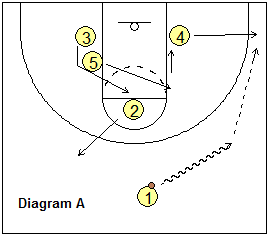
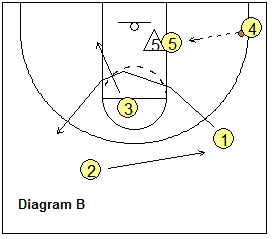
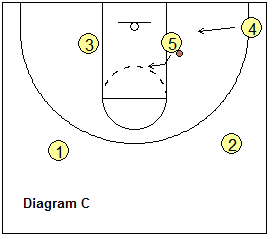
If the X5 defender is playing behind O5, the pass goes from O4 to O5 (diagram B). Once O5 receives the pass, O3 cuts to the weakside low block. O5 makes a post move and tries to score. If O3's defender gives help, O3 should be open for an easy pass and lay-up (or dunk). If O5 makes a move to the paint (diagram C), O4 slides toward the hoop for either a pass, or an offensive rebound.
If O5 makes the baseline drop-step move (diagram D), O4 slides higher and into the middle for rebounding position. In either case, the rebounding triangle is established.
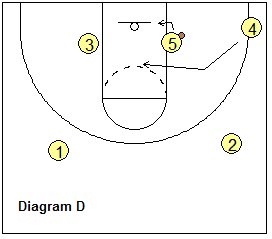
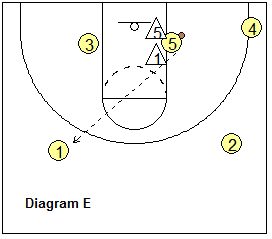
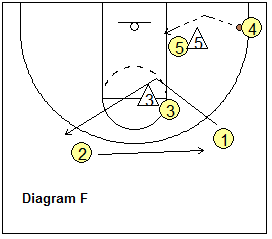
If the X1 defender drops inside to double-team O5 (diagram E), O5 skip passes out to O1 for an open 3-point shot. Here again, we have good rebounding position on the outside shot.
Oftentimes, the X5 defender full-fronts O5 in the low-post, denying the pass from O4 (diagram F). It's important for O3 to stay at the ball-side elbow until the pass is actually made to O5 (as in diagram B above). If O5 is denied the pass, O3 remains at the elbow. This takes away the helpside defense and frees up O5 for an over-the-top lob pass from O4 (diagram F).
If X3 drops inside to help prevent the lob, then O4 passes to O3 at the elbow (diagram G). O3 could shoot the jump-shot from the elbow. O3 could also shot-fake and dribble-drive up the left side of the lane for a lay-up (diagram H). Also note that O5 seals the X5 defender outside, and moves to the basket for a possible lob pass from O3. O3 could also skip pass to O1 for a 3-point shot (diagram G).
If the pass to O3 at the elbow is not open (the X2 defender might have dropped inside), then O4 passes back out to O2 on the wing (diagram I). O5 moves to the opposite low block.
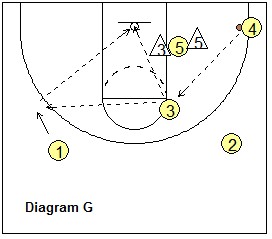
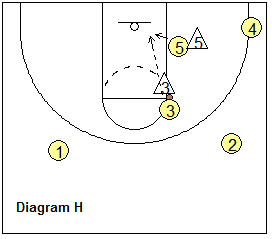

O2 has several options here. First, a pass to O3 at the ball-side elbow (diagram I) re-opens the options we just discussed - O3's shot from the elbow, a pass inside to O5 (diagram J), a skip-pass to O1, or a shot-fake and dribble-drive up the right side of the lane.
Secondly, O2 could dribble-drive around O3, running a pick and roll play (diagram K). O2 could also skip-pass to O1, or pass back to O4 in the corner, and re-establish the T-game pattern (diagram L). In this case, O3 now cuts to the ball-side low block and posts-up, as O5 cuts to the ball-side elbow, vacated by O3. O2 and O1 once again exchange positions.
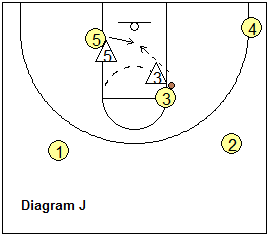
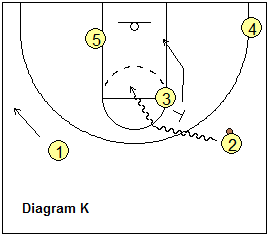
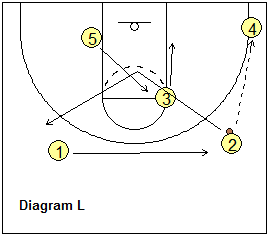
Alternative Entries into the Offense
Man-to-man pressure defenses may try to disrupt the offense by denying the first pass to the corner. There are several other ways to get into the offense.Diagram M shows X4 denying the pass to the corner. This is a read for O3, who should recognize the denial, and cut up to the weak-side elbow (to move his defender away from the hoop). X5 will usually deny O5, and so O5 seals the defender, cuts to the hoop and receives the over-the-top lob pass from O1.
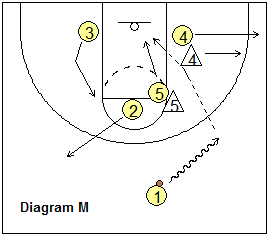
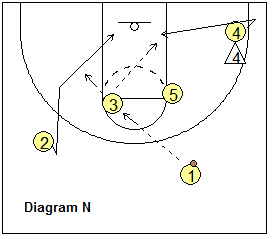
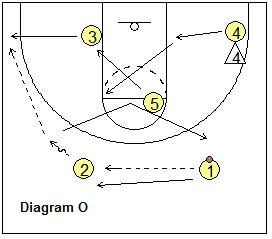
O1 could also pass to O3 at the left elbow (diagram N). This sets up good back-door options against a denying, pressure defense. O2 and O4 could back-cut and receive a pass from O3 for a lay-up.
Another entry option is for O1 to pass to O2 (diagram O), and O2 starts the offense on the left side, with O3 cutting to the corner for the pass from O2. O5 moves to the ball-side block and O4 flashes to the ball-side elbow. O1 and O2 exchange.
"Single-Post" Option and Continuity
You can use either the single-post offense, or the triple-post offense. For teams that have a dominant inside player, who doesn't like to get far from the basket, the single-post offense is best. This keeps your big guy near the hoop at all times. Teams that do not have a true, inside player (rather three good forwards) would do better with the triple-post option described below.Diagram P shows the single-post continuity after the ball has already gone to the right corner, and then back out to O2 on the right wing. O2 passes to O1, and O1 immediately dribbles to the left wing. O5 screens for O3, and O3 cuts to the left corner. O5 will then initially flash to the ball-side elbow, but will dive back to the low block once O1 passes to O3 in the corner. O4 flashes to the high-post. O1 and O2 exchange.
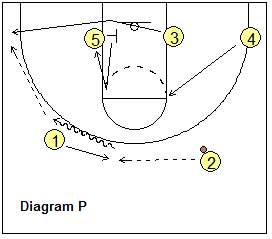
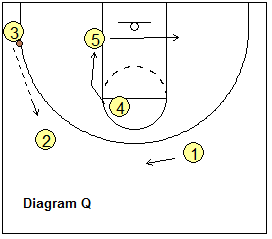
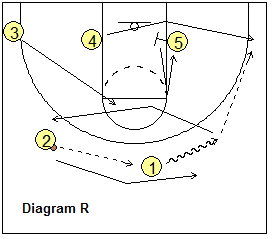
Diagram Q shows another ball-reversal. The ball is passed back out to the wing to O2. O5 slides across the lane and O4 drops inside, and will eventually cut to the right corner, using O5's screen (diagram R). O1 receives the pass from O2, and O5 moves to the right elbow. O1 dribbles to the right wing and passes to O4 in the corner. O5 cuts to the ball-side low block and posts-up. O3 cuts to the high-post, and O1 and O2 exchange.
This single-post movement always keeps O5 inside, on either low block or the elbow.
"Triple-Post" Option and Continuity
Use the triple-post offense if you have three good forwards but no dominant inside post player. The triple-post option is more flexible, with O3, O4 and O5 interchanging positions, and as a result, there is more player movement. Also, if one of the three post players has a size or skill advantage over his/her defender, you can plan to have that player posting up inside more. This is also a good strategy if his/her defender is in foul-trouble.Diagram S shows, after the initial pass to the corner, O4 passes back out to O2 on the wing. O2 passes to O1, and O1 dribbles to the left wing (diagram T). O5 cuts to the left corner for the pass from O1. O3 slides across the lane to the ball-side elbow, and will cut to the ball-side low block once the ball is passed to the corner. O4 moves to the weak-side block and, once the pass goes to the corner, flashes to the ball-side elbow (diagram U). O1 and O2 exchange.

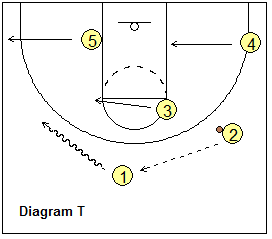
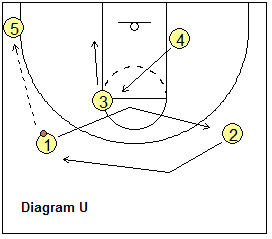
Diagram V shows the pass going back out to O2 on the wing. O2 passes to O1. O3 and O4 simply slide across the lane, as O5 moves inside to the left low block. O1 dribbles to the right wing. O3 cuts to the right corner for the pass from O1 (diagram W). On the corner pass, O4 dives down to the ball-side low block and posts-up. O5 flashes to the ball-side elbow, and O1 and O2 exchange.
The triple-post option features all three inside players rotating into each of the post positions (corners, both low-blocks and elbows).
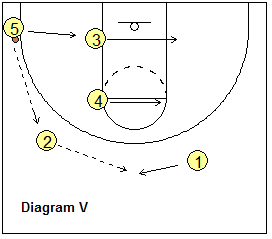

T-Game as a Zone Offense
The T-game often works well against zone defenses. In fact, some coaches use it only as a zone offense. When attacking zones, the corner, low-block, elbows, and high-post are usually good spots to have filled - and the T-game fills all those spots. Offensive rebounding against the zone is a strong feature as well. Either the single-post or the triple-post offense can be used, and the post-player movements are basically the same as previously described.Against zones, our guards O1 and O2 have slightly different rules. They do not exchange sides but stay on the same side that they began on that possession. If the zone double-teams the corner, we must have the guard already there on the wing for a quick pass back out.
The ball-side guard must be open for the pass from the corner, and can think about attacking with the dribble. The weak-side guard has the whole opposite side of the court to work in, spotting up for a skip-pass, or maybe a back-door cut for a pass and lay-up. He/she is also a back-side rebounder.
Diagram X shows our usual T-game motion with O1 dribbling right and passing to O4 in the corner. O5 dives to the block for a possible pass from O4. A good tip here is to make sure that the weak-side post (O3) does not flash to the elbow until after the pass is made to the corner. Against the 1-3-1 zone, O3 could be open on the weak-side block for a lob-pass if the inside, low defender starts cheating to the right side. At least keeping O3 there will tend to keep that defender "honest", and this helps prevent a double-team in the corner.
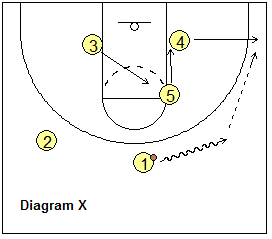


Diagram Y shows a good option against zones. O4 can often pass to O3 at the elbow. O3 can shoot, or pass to O5 cutting inside, or skip-pass out to O2 on the left wing.
If O4 passes back out to O1 on the wing, O1 has options as well. O1 could also pass to O3 at the elbow (diagram Y), or skip-pass to O2, or dribble-drive the seam, using O3 as a screener (diagram Z). After screening, O3 rolls to the hoop on the pick and roll play. Off the dribble, O1 could shoot, or pass to O3, O5, or out to O2.
Skip-passing Rotation
Our post players might delay a couple seconds before rotating, giving O2 (diagram SK1) a chance to either dribble-drive or shoot (in which case we maintain our inside and weak-side rebounding positions). Or O2 could quickly pass to the now ball-side post (O5 in diagram SK1) for a quick post-move.Diagram SK1 shows the offensive rotation for the "triple-post" offense on a skip-pass. O5, after initially sealing and posting-up, cuts out to the ball-side corner, and O3 cuts to the ball-side block once the pass goes to the corner. O4 then flashes to the ball-side elbow (after the pass is made to the corner).
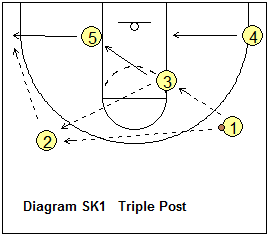

Diagram SK2 shows the rotation for the "single-post" offense on a skip-pass. Again, with the single-post offense, we like to keep O5 inside. On the pass from O1 to O2, O5 flashes to the ball-side elbow. O3 cuts inside and out to the left corner for the pass from O2. O4 moves inside to the weak-side low block. O5 cuts to the ball-side block on the pass to the corner, and O4 flashes to the ball-side elbow.
Summary
In summary, the T-game is a patterned, inside power offense that provides high-percentage shots in the paint as well as offensive rebounding. Although somewhat predictable, there is flexibility and continuity. It can be used against both man-to-man and zone defenses, and is fairly easy to learn.In teaching the offense, breakdown the three post players, going through the basic rotations (either single or triple post). Then bring in the two guards for the entire package. Practice it against both man-to-man and zone defenses.
The article in the members section and Playbook includes a detailed Animation!